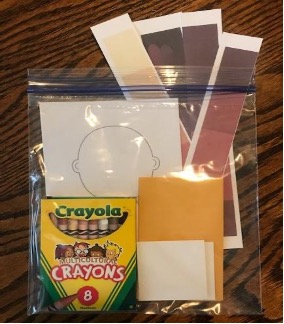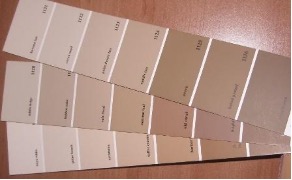Children notice and wonder about the physical features of themselves and others. They are constantly observing themselves in mirrors and others throughout the day. They wonder, ask questions, and create theories about the similarities and differences that they notice. We can support and deepen their exploration and learning by intentionally providing materials, books and experiences that invite them to experience, represent, and discuss the ways that we are alike and different. Here is one example designed to explore the many shades of people’s skin.

Lesson 1: Exploration of crayons
Key Concept & Vocabulary – Shades and shading
Book – Shades of People (S. Rotner & S. Kelly)
Materials – Shades of people crayons, 2” x 2” cards, one envelope
- Read Shades of People and pause at, “It’s hard to get the right shade when I paint.” Say, “You might have discovered that it is hard to draw yourself and your family with a standard box of crayons. It is not a very fair set of crayons, because it does not have crayons for the shades of people. So, today we are adding a new set of crayons. Let’s learn how to use them.”
- Invite children to take out their crayons and discuss the colors. “What do you notice?”
- Discuss that there are no people who have white or black skin. That those crayons are there to help us try to make the right shade of brown for each person, or to help of make people’s eyes and hair. Then, have children set those two crayons aside (as they are not part of this lesson).
- Demonstrate first how to use crayons to create shades – pushing down lightly for a lighter shade and firmly for a darker shade. Use one of the 2” x 2” cards. Begin with a medium brown shade.
- Invite students to take out their 2” x 2” cards. Using one crayon at a time, color gently on one side, and firmly on the other side to create their own color swatches for each crayon.
- Have them place their samples into one of the envelopes and place the crayons back in their box. Then, everything back in their kit.
Lesson 2: Cutting Strips
Key Concept & Vocabulary – Names of shades of brown
Book – All The Colors of the Earth (S. Hamanaka)
Materials – Shades of people strips, scissors, one envelope

- Read All the Colors of the Earth – pause on each page to review and record (write large onto chart paper) the different words for the various shades of people in the book. Start a class list of words for “shades of brown”, to be added to throughout these lessons.
- Invite children to take out one (or all – it is up to you!) of the cutting strips. Demonstrate how to, then invite them to, cut the strip into individual color swatches.
- Invite children to try to name the various swatches they have creates. Place the color swatches in the second envelope.


Lesson # 3: Using Color Swatches (from hand-made samples or cutting strips)
Key Concept & Vocabulary – Seriations – dark to light (notice if you default to saying light to dark, try to disrupt having lightness be first)
Book – Shades of People (S. Rotner & S. Kelly)
Materials – Envelopes with color swatches
- Re-read Shades of People. Pause on each page to review and add to your list of words the various shades of people. Pause and focus on the second to last pages (“light and dark and everything in between”).
- Invite children to try to organize and seriate their swatches from darkest to lightest. (Use the shaded cloud shape as a guide). Ask them to explain their work and decisions.
Lesson # 4: Using Color Swatches (from hand-made samples or cutting strips)
Key Concept & Vocabulary Matching with items in your classroom/home – shades of brown vocabulary
Book – Revisit All the Colors of the Earth
Materials – Envelopes with color swatches
- Re-read All the Colors of the Earth and/or your list of color words.
- Invite students to find shades of brown around the classroom. They could try to match them to a swatch, or just find and report on colors.
- Add the new colors to your list, for examples: bookshelf brown, wood floor brown, peanut butter, etc. You could also have families send you pictures of brown items from home. You might make your own book of shades of brown.
Lesson # 5: Using Color Swatches (from hand-made samples or cutting strips)
Key Concept – Matching with people
Book – The Colors of Us (K. Katz)
Materials – Color Swatches
- Read the Colors of Us.
- Invite students to use their color swatches to match with the characters in the book, their own skin color, and/or the color of people in their classroom, home or care setting. Can they name the colors of the people around them?
- Sing, We Are Made of the Colors of Earth
Lesson # 6: Using Color Swatches (from hand-made samples or cutting strips)
Key Concept – Naming and Matching Colors
Book – The Colors of Us (K. Katz)
Song – Color of Me Song
Materials – Envelopes full of color swatches

- Re-read through the colors of us, pausing and inviting children to select (from their collection) the colors mentioned in the book. Repeat the names of the colors, “Jo-Jin is the color of honey.”
- Ask students to find a sample close to their own skin color. Hold it up next to the back of their hand to show their peers. Work together to name the color – inviting the children who is sharing to start, then inviting the group to help out, if needed. Reference the list you have been making.
Lesson # 7: Drawing Faces
Book – Two Eyes, A Nose, and A Mouth (R.G.Intrater)
Materials – Shades of People Colored pencils and Crayons, face templates
- Read Two Eyes, A Nose and A Mouth
- Sing Eyes, Ears, Nose and Mouth
- Demonstrate and teach, using the face template, how to first draw features (using the colored pencils) then add skin color on top, gently with the crayon that is the best match.
- Demonstrate and encourage children to explore all of their crayons and colored pencils to find colors that match their eyes, hair, lips, etc. Provide mirrors, whenever possible.
Extensions and Modifications
- Read – All the Colors We Are / Todos Los Colores de Nuestra Piel
- Listen to and sing “We Are Made of the Colors of Earth”
- Listen to and sing “The Color of Me”
- Invite students to draw faces for members of their families.
- Invite students to freely explore and play with shades of brown.
- Encourage students to use shades of brown in all of their drawn work (journals, self-portraits, illustrations, etc.)
- Develop a similar series of lesson for exploring hair color and texture. Use various yarns, wool, and dolls hair to accurately represent various types of hair.
- Expand your exploration by using the Big Idea Guide – Me and My Friends.